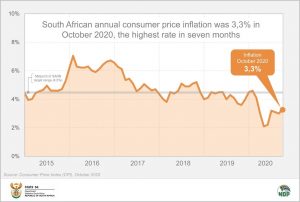Inflation edges up as food and drink prices bite
Annual consumer inflation hit a seven-month high in October, driven largely by rising prices for food and non-alcoholic beverages. Headline inflation was 3,3%, the biggest annual rise since March when the rate was 4,1%.
The monthly increase in October was 0,3%, edging up from 0,2% recorded in both September and August.
Food and drink inflation picks up
Prices in the food and non-alcoholic beverages category jumped by 1,4% on average between September and October, leading to a 5,4% annual increase. This is the biggest annual rise for this category since September 2017 when the country was emerging out of drought.
Food and non-alcoholic beverages was the main contributor to the 0,3% monthly rise in consumer inflation in October 2020, and the second largest contributor to the annual rate of 3,3%.
Large annual price increases were recorded for fruit (13,9%); oils and fats (9,7%); sugar, sweets and desserts (9,7%); and milk, eggs and cheese (6,5%). All food categories recorded above headline increases in October with the exception of bread and cereals, which registered an increase on par with the headline rate (3,3%).
There was a sizeable gap between hot and cold in the annual inflation rates for non-alcoholic beverages: 6,1% for hot drinks and 1,7% for cold.
Brewing tea just became that much more expensive
If you are an avid tea drinker, it might be disheartening to learn that tea was the main driver behind the rise in hot beverage prices. Black tea prices jumped by 3,9% in October compared with September, resulting in an annual rise of 10,4%.
It’s not only your cup of tea that’s become more expensive. Prices of popular condiments have also risen sharply. Milk prices have seen large increases, with full cream long-life milk 8,1% more expensive than it was a year ago. The price of white sugar increased by 13,9% over the same period.
The price of filling your kettle and switching it on to boil has also risen. Municipal water and electricity tariffs both increased on average by 6,0% when they were surveyed in July.
Rooibos tea, on the other hand, has risen at a much slower 3,3% over the last year. However, despite the slower growth in price, rooibos is more expensive than black tea. Rooibos will set you back an average of 57c per tea bag, if we assume that a typical tea bag contains 2,5g of tea. Black tea is priced at 35c per bag on average.
Travel and holiday inflation dampened
Tourism and travel activity continues to be subdued as the country slowly eases its lockdown restrictions. A number of categories in the inflation basket recorded an annual fall in prices in October, most notably fuel (-9,1%), package holidays (-3,7%) and hotels (-3,3%).
For more information, download the latest Consumer Price Index (CPI) release here.
Similar articles are available on the Stats SA website and can be accessed here.
For a monthly overview of economic indicators and infographics, catch the latest edition of the Stats Biz newsletter here.


